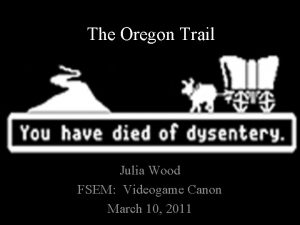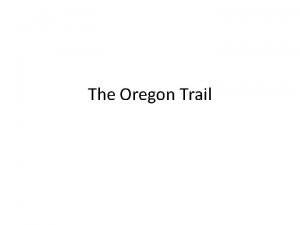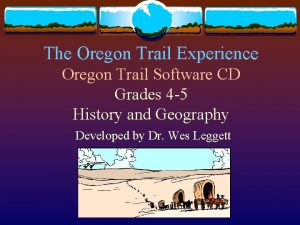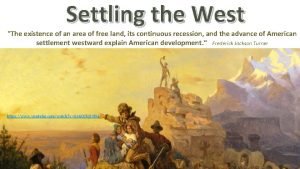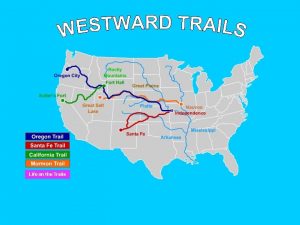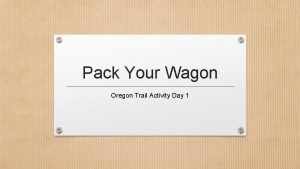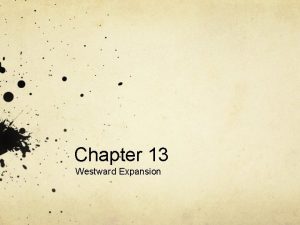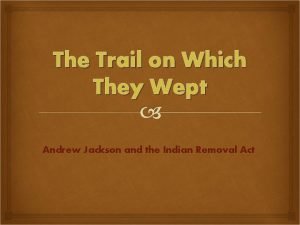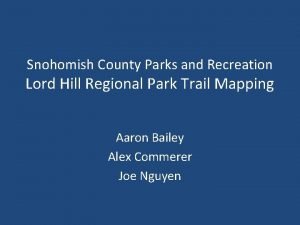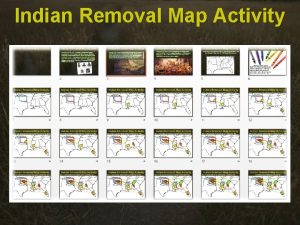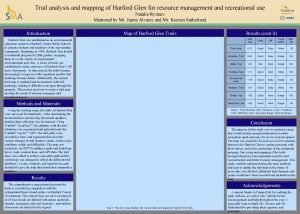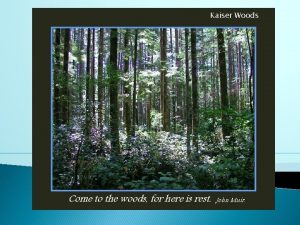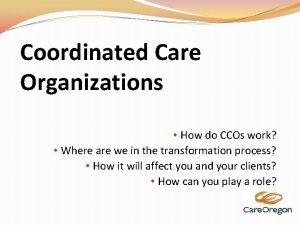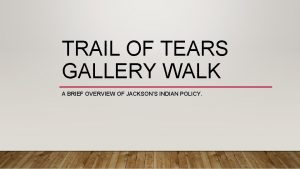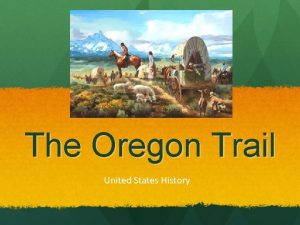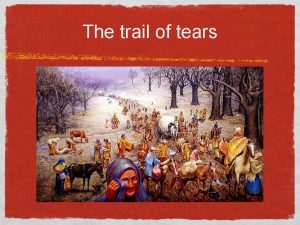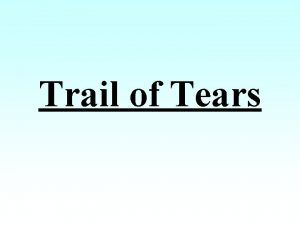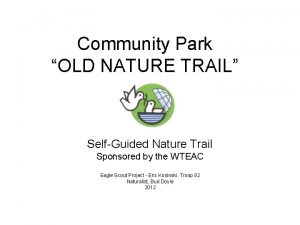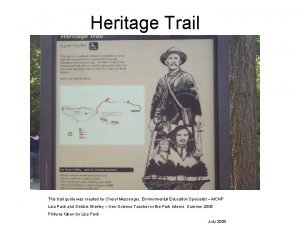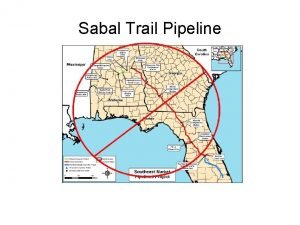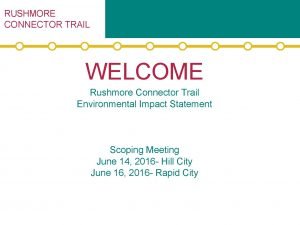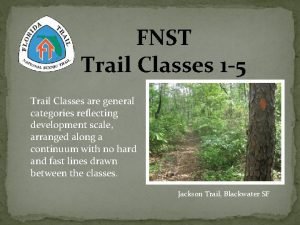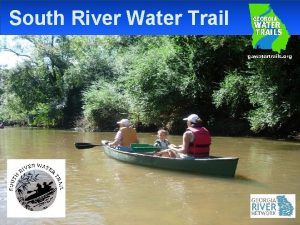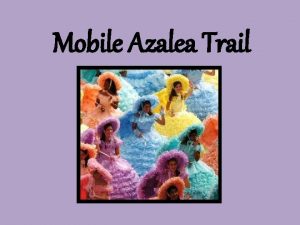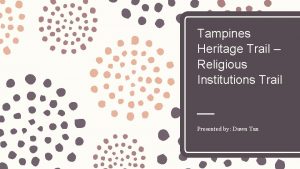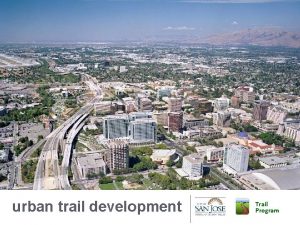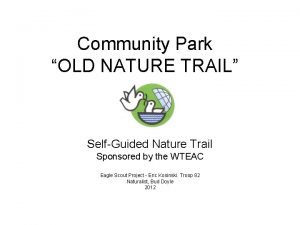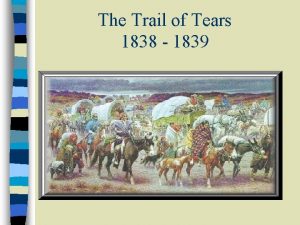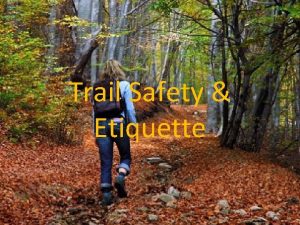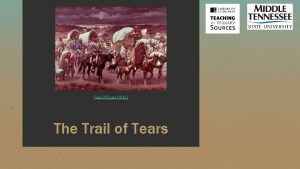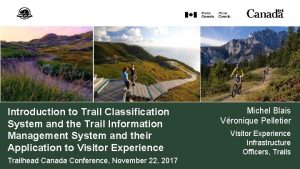THE OREGON TRAIL MAP OF THE OREGON TRAIL



























































- Slides: 59

THE OREGON TRAIL

MAP OF THE OREGON TRAIL

WHAT WAS THE OREGON TRAIL? Between 1840 and 1869, about 500, 000 people traveled west in covered wagons. It was the only practical, overland path for getting to the western United States. The trail was about 2, 000 miles It would take about 5 months to cross, walking 12 -15 miles a day The Trail stretched 2, 000 miles from Independence, Missouri to Oregon City, Oregon. The trail crossed difficult terrain and the pioneers walked across plains that seemed like they would never end, crossed rivers, and climbed up high mountains.

WHY OREGON? Pioneers traveled to Oregon for several reasons including: free fertile (good) land, for business and trade opportunities, and to head to California for gold. Most went west to seek a better life.

WHO TRAVELED WEST? Average people, mostly farmers, who were looking for a better life. They were willing to sell their homes, leave friends and families, and pack up their belongings and head west. The first were the trappers who had been in the Oregon Country for fifty years working for American and British companies trapping beaver and other fur-bearing animals for trade to Europe and China. A few missionaries and religiously oriented members also traveled the Trail. Merchants hoping to capitalize on new market opportunities.

WHEN DID PIONEERS BEGIN THEIR JOURNEY TO OREGON? Pioneers left Independence, Missouri in April hoping to arrive in Oregon by September or October. It was critically important to leave at the appropriate time of year. If they left too early in the spring, there would not yet be enough grass on the prairie to feed the livestock (animals). If they left too late in the spring, they risked being trapped in the snow in the mountains.

PREPARATION The preparations for a journey west on the Oregon Trail took more than a year. Pioneers had to sell land, horses, businesses, and property while gathering the supplies they would need on the journey They would have to say goodbye to family and friends.

HOW DID THEY GET THERE? In a covered wagon pulled by oxen

The Covered Wagon

WAGONS 12 feet long 11 feet high 4 feet wide Tough, white canvas cover The wagons hauled belongings and supplies, but most pioneers did not ride in them; they walked most of the time. The extra weight of people in the wagon would put a strain on the animals. The small, lightweight wagons could make it through the 2000 mile journey.

OXEN A team of 4 to 6 oxen pulled each wagon. Oxen were slower than mules or horses but were cheaper, survived on prairie grass better, and had better stamina. They were less likely to run off and less likely to be stolen by the Indians. Their normal speed of two mile per hour was a comfortable speed for the thousands who walked along with the wagons. They suffered exhaustion, starvation, thirst, poisonous water, and sore feet. Sometimes booties were made to wrap an ox's sore feet. Families had great affection for their oxen, giving them names like any pet. When one died, the whole family grieved.

SUPPLIES The inside of the wagon was crammed with the supplies needed to make the journey and for use once the settlers reached Oregon. In order to successfully complete the journey, they would need lots of food, basic kitchen equipment such as a cooking kettle (Dutch oven), fry pan, coffee pot, tin plates, cups, knives and forks. Spare wagon parts were a must in order to fix the wagon. They would also take clothing, guns, ammunitions, and farm equipment and tools. Wagon space was so limited that pioneers were forced to leave most of the comforts of home behind.

WHAT DID THEY BRING?


INDIANS Trouble with Indians was rare. Indians usually provided information about the trail ahead and were sometimes even hired as guides and to swim livestock across the rivers. They often stopped to trade buffalo robes and buckskin moccasins, fringed shirts and leggings for tobacco, ironware and worn-out clothing with the pioneers.

WHAT DANGERS DID PIONEERS FACE? Traveling the Oregon Trail was very difficult and dangerous. Dangers included: Disease – Cholera (causes by drinking infected water), pneumonia, measles, small pox could cause death Lack of food – run out or you can’t hunt Crossing Rivers with out losing your wagon or drowning Injuries – Usual no doctors - cuts and broken bones could become infected wagon accidents (typically being run over by a wagon) Not enough water and quality of water

WHAT DANGERS DID PIONEERS FACE? Wagons braking down on the trail, wheels crushing children Bad weather (snow, heat, thunderstorms) and dangerous terrain (mountains). About 10% of pioneers died on the trail from either disease, overwork, hunger, or accidents

CHOLERA: #1 KILLER OF PIONEERS ON OREGON TRAIL Perhaps the biggest problem on the Trail was a mysterious and deadly disease--called cholera for which there was no cure. Often, a pioneer would go from healthy to dead in just a few hours. Sometimes they received a proper burial, but often, the sick would be abandoned, in on the side of the trail. They would die alone. Making matters worse were animals that regularly dug up the dead and scattered the trail with human bones and body parts. John Clark: "One woman and two men lay dead on the grass and some more ready to die. Women and children crying, some hunting medicine and none to be found. With heartfelt sorrow, we looked around for some time until I felt unwell myself. Got up and moved forward one mile, so as to be out of hearing of crying and suffering. "

WAGONS WERE DANGEROUS The wagons didn't have any safety features. If someone fell under the massive wagon wheels, death was instant. Many lost their lives this way. Most often, the victims were children. Edward Lenox: "A little boy fell over the front end of the wagon during our journey. In his case, the great wheels rolled over the child's head----crushing it to pieces. “

Dear Journal, May 5, 1852 We have only just begun our journey and we have already come again severe challenges. As we tried to cross the great Missouri River today we had to disassemble each wagon and ferry them across one by one. After working all day we still only a third of the wagons on the west bank. On top of this painstaking and time intensive work the men struggled to get the oxen to swim across. They were so afraid of the strong current and many found themselves thrashing in thick mud. Several oxen were swept down stream or had to be left for they were stuck too deep in the mud. I fear after this experience we will never make it to the land of milk and honey. Sincerely, Hattie Smith

Sarah Cummins (A traveler on the trail): "The traveling was slow and toilsome (difficult); slopes (mountains) were almost impassible for man and beast. As night was coming on, it seemed we all must perish, but weak, faint and starving we went on. I could scarcely put one foot before the another. I weighed less than eighty pounds at the time. My own party had been 14 days with only nine biscuits and four small slices of bacon. “

CIRCLE THE WAGONS The first order of business at the end of the day was forming a corral by pulling the wagons into a circle. One wagon was chained to the rear of the next to form a fence. This guarded against thieves and wild animals. The animals and pioneers slept inside of the circle. One man served as a guard at night.

DAILY LIFE ON THE TRAIL

MORNING ROUTINE Sun up - yoke the oxen (attach them to wagon), cook the breakfast; and hit the trail. . . begin walking by 7: 00 am. They walked 12 -15 miles a day. They had an hour break for lunch. This gave animals time to rest and graze

MEAL PREPARATION They usually ate bacon and bread and coffee If lucky, they would have quail or buffalo. Sometimes they ate beans, rice, dried fruit, and ham Pioneers cooked their meals over an open fire.

JOBS ALONG THE WAY Men - drive/fix the wagons, hunt (rabbits, prairie chickens, and buffalo), fish, protect/take care of the family and the animals Women - sew, wash laundry, cook, teach and take care of the children Children - milk the cow, fetch water, watch over smaller children, gather firewood/buffalo chips, help pack and unpack, herd the livestock, help cook, wash, and fish

CHILDREN ON THE OREGON TRAIL Watch the following video: https: //www. youtube. com/watch? v=A 9 m 6 k 02 h. E 3 k

EVENING ROUTINE 6 p. m. - they set up camp, built a fire, circled the wagons, and started to make dinner. Livestock were driven out to pasture to eat. Perhaps hunters came in with choice parts of buffalo or antelope, and everyone enjoyed a feast. After supper, the children played their favorite games, the adults gathered in groups and talked. Some of the young folk danced and sang to the music of the fiddle or accordion. 8 -9 p. m. - they would go to bed, sleeping on the ground. Fatigue and exhaustion made the ground seem soft.

WHAT WAS IT LIKE ON THE TRAIL?

Independence, Missouri

• This is where the Oregon Trail began! • Pioneers bought supplies, hired a trail guide (someone who knew the way because they had made the trip before) if they could to guide them on their journey and they formed a wagon train. • Wagon trains were groups of wagons that traveled together. There were many advantages of traveling in groups…they could share supplies, help each other, work together, and keep each other company.

MAP OF THE OREGON TRAIL

Fort Kearny Located in Nebraska

FORT KEARNY Military post built to protect the pioneers on the Oregon Trail Fort Kearney was the first of three trading posts on the trail. At Fort Kearney they could rest for a few days, buy more food and supplies, and send mail to friends and family back east. Food was more expensive at the fort than back home In late May as many as 2, 000 emigrants and 10, 000 oxen might pass through in a single day.

MAP OF THE OREGON TRAIL

CHIMNEY ROCK Located in Nebraska

CHIMNEY ROCK Nearly 300 feet tall Made of primarily of clay with layers of volcanic ash and sandstone Helped pioneers know they were getting closer to Oregon Has become smaller due to erosion and lightning They carved their names in the rock When they reached here, they were just less than one-third on their way to Oregon

CHIMNEY ROCK https: //www. youtube. com/watch? v=l. Md 5 vm. Gw. Sho Watch the first 60 seconds of the following video:

INDEPENDENCE ROCK Located in Wyoming

INDEPENDENCE ROCK Giant, granite structure 130 feet high Most pioneers reached this point on July 4 th Many Pioneers carved their initials into the rock Independence Rock became one of the great bulletin boards of the Oregon Trail-a place to look for word of friends ahead or leave messages for those coming behind.


South pass Located in Wyoming

South pass § Pioneers crossed the Rocky Mountains by taking South Pass, which was a gap in the mountains several miles wide. It provided a gradual, winding, gentle climb into the Rockies. § The road began the climb into the Rocky Mountains, which meant extra hardships for both man and animal. To keep the animals moving, it often became necessary to lighten their loads. The road became littered with stoves, clothes trunks, tools, tables, cooking pots and even food. § They barely noticed they were climbing. § Here they faced hot summer days sprinkled with thunderstorms and hailstorms followed by cold nights, sometimes snow. § Pioneers were only half-way to their destination. There was still 1, 000 miles to go!

MAP OF THE OREGON TRAIL

Blue Mountains Located in Oregon

BLUE MOUNTAINS Crossing these mountains was very dangerous and difficult. Their pace was extremely slow. At times the path was so steep that wagons had to be unloaded and taken apart. Then chains and pulleys would be used to pull the wagons through the steep mountains. The animals would be guided across separately. On the other side of the mountain, the wagons were reloaded. Wagons could tip over and accidents could happen. Sometimes trees had to be cut down and boulders moved to make way for the wagons. Snowstorm would create mud and snow they would have to walk through. They would suffer from the cold and wetness.

ROPES AND PULLEYS

MAP OF THE OREGON TRAIL

COLUMBIA RIVER Located in Oregon

COLUMBIA RIVER • The river was full of rapids, huge rocks, and high cliff walls all posing tremendous dangers to the travelers. Many pioneers lost their lives at this point so near to their final destination. It was the most dangerous part of the trip. They used rafts to float the wagons down the river. • Pioneers could hire a ferryman to take them across the river, but their prices were very high. Others hired Indians to get them down the river, while some pioneers built their own rafts. • Animals were walked along the narrow footpath beside the river.

RAFTING DOWN THE COLUMBIA RIVER

RAFTING DOWN THE COLUMBIA RIVER

RAFTING DOWN THE COLUMBIA RIVER

COLUMBIA RIVER Lindsey Applegate: “One of our boats, containing six persons, was caught in one of those terrible whirlpools and upset. My son, ten-years-old, my brother Jesse's son Edward, same age, were lost. It was a painful scene beyond description. We dared not go to their assistance without exposing the occupants of the other boat to certain destruction (death). The bodies of the drowned were never recovered. "

MAP OF THE OREGON TRAIL

OREGON CITY, Oregon

OREGON CITY, OREGON This was the final stop in the 2, 000 mile long trail-Oregon City, Oregon! From Oregon City the pioneers fanned out in all directions to stake their claims and begin their new lives. They had reached the promised land. The government gave 640 acres of fertile farmland to every male citizen. They went to the land office where they could file their land claim to begin the proccess of getting land. The pioneers soon learned that the legend of Oregon was true.

OREGON CITY, OREGON Emigrant James Miller: "On our arrival in Oregon City, I found everything quite different from what I expected. There were three small churches, three stores, two blacksmiths shops, two flour mills and one weekly newspaper, the Oregon Spectator. My father purchased a house and lot and we moved into it soon after we arrived, and commenced the sale of our boots and shoes. For fine boots, we got five dollars a pair. " Emigrant Overton Johnson: We were happy, after a long and tedious tour, to witness the home of civilization. To see mills, storehouses, shops. To hear the noise of the workman's hammer; to enjoy the warm welcome of countrymen and friends. "

OREGON TRAIL GAME https: //archive. org/details/msdos_Oregon_Tr ail_The_1990
 Oregon trail 2001
Oregon trail 2001 Oregon trail chores
Oregon trail chores Oregon trail software
Oregon trail software Dangers on the oregon trail
Dangers on the oregon trail Fort hall on the oregon trail
Fort hall on the oregon trail Oregon trail pack your wagon
Oregon trail pack your wagon The oregon trail
The oregon trail Andrew jackson trail of tears map
Andrew jackson trail of tears map Lord hill park trail map
Lord hill park trail map Indian removal act map activity answers
Indian removal act map activity answers Sabal trail pipeline map
Sabal trail pipeline map Harford glen park
Harford glen park Kaiser woods olympia trail map
Kaiser woods olympia trail map Stockley center
Stockley center Seven wonders of oregon map
Seven wonders of oregon map Oregon cco map
Oregon cco map Hình ảnh bộ gõ cơ thể búng tay
Hình ảnh bộ gõ cơ thể búng tay Bổ thể
Bổ thể Tỉ lệ cơ thể trẻ em
Tỉ lệ cơ thể trẻ em Voi kéo gỗ như thế nào
Voi kéo gỗ như thế nào Tư thế worm breton là gì
Tư thế worm breton là gì Chúa sống lại
Chúa sống lại Các môn thể thao bắt đầu bằng tiếng chạy
Các môn thể thao bắt đầu bằng tiếng chạy Thế nào là hệ số cao nhất
Thế nào là hệ số cao nhất Các châu lục và đại dương trên thế giới
Các châu lục và đại dương trên thế giới Cong thức tính động năng
Cong thức tính động năng Trời xanh đây là của chúng ta thể thơ
Trời xanh đây là của chúng ta thể thơ Mật thư anh em như thể tay chân
Mật thư anh em như thể tay chân Làm thế nào để 102-1=99
Làm thế nào để 102-1=99 độ dài liên kết
độ dài liên kết Các châu lục và đại dương trên thế giới
Các châu lục và đại dương trên thế giới Thơ thất ngôn tứ tuyệt đường luật
Thơ thất ngôn tứ tuyệt đường luật Quá trình desamine hóa có thể tạo ra
Quá trình desamine hóa có thể tạo ra Một số thể thơ truyền thống
Một số thể thơ truyền thống Cái miệng nó xinh thế
Cái miệng nó xinh thế Vẽ hình chiếu vuông góc của vật thể sau
Vẽ hình chiếu vuông góc của vật thể sau Thế nào là sự mỏi cơ
Thế nào là sự mỏi cơ đặc điểm cơ thể của người tối cổ
đặc điểm cơ thể của người tối cổ V cc
V cc Vẽ hình chiếu đứng bằng cạnh của vật thể
Vẽ hình chiếu đứng bằng cạnh của vật thể Vẽ hình chiếu vuông góc của vật thể sau
Vẽ hình chiếu vuông góc của vật thể sau Thẻ vin
Thẻ vin đại từ thay thế
đại từ thay thế điện thế nghỉ
điện thế nghỉ Tư thế ngồi viết
Tư thế ngồi viết Diễn thế sinh thái là
Diễn thế sinh thái là Dot
Dot Các số nguyên tố
Các số nguyên tố Tư thế ngồi viết
Tư thế ngồi viết Lời thề hippocrates
Lời thề hippocrates Thiếu nhi thế giới liên hoan
Thiếu nhi thế giới liên hoan ưu thế lai là gì
ưu thế lai là gì Khi nào hổ con có thể sống độc lập
Khi nào hổ con có thể sống độc lập Khi nào hổ mẹ dạy hổ con săn mồi
Khi nào hổ mẹ dạy hổ con săn mồi Sơ đồ cơ thể người
Sơ đồ cơ thể người Từ ngữ thể hiện lòng nhân hậu
Từ ngữ thể hiện lòng nhân hậu Thế nào là mạng điện lắp đặt kiểu nổi
Thế nào là mạng điện lắp đặt kiểu nổi Trail kofax kapow
Trail kofax kapow Trail of tears worksheets
Trail of tears worksheets
